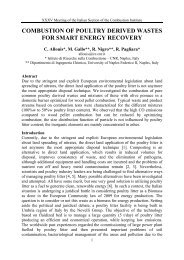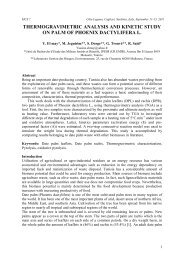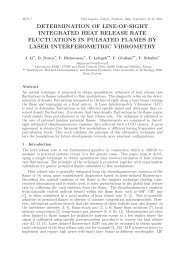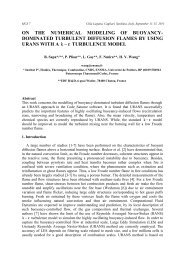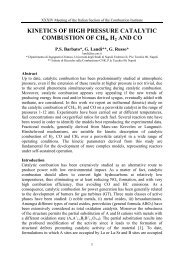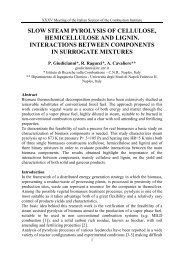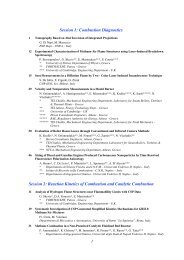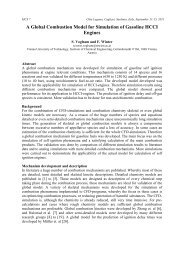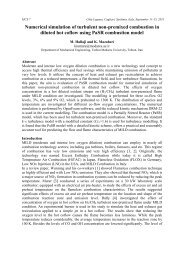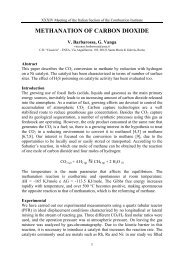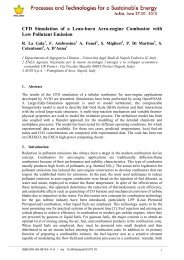seawater so2 scrubbing in a spray tower for marine application
seawater so2 scrubbing in a spray tower for marine application
seawater so2 scrubbing in a spray tower for marine application
Create successful ePaper yourself
Turn your PDF publications into a flip-book with our unique Google optimized e-Paper software.
XXXV Meet<strong>in</strong>g of the Italian Section of the Combustion Institute<br />
SEAWATER SO2 SCRUBBING IN A SPRAY<br />
TOWER FOR MARINE APPLICATION<br />
G. Caiazzo*, G. Langella**, F. Miccio*, F. Scala*<br />
scala@irc.cnr.it<br />
* Istituto di Ricerche sulla Combustione, Consiglio Nazionale delle Ricerche,<br />
Piazzale V<strong>in</strong>cenzo Tecchio 80, 80125 Napoli, Italy<br />
** DIME, Dipartimento di Ingegneria Meccanica per l’Energetica, Università degli Studi di<br />
Napoli Federico II, Via Claudio 21, Napoli 80125, Italy<br />
Abstract<br />
A <strong>seawater</strong> <strong>spray</strong> scrubber was set up and tested with focus on desulfurization of<br />
mar<strong>in</strong>e eng<strong>in</strong>e exhaust gas. Experimental tests were carried out simulat<strong>in</strong>g typical<br />
exhaust conditions of a mar<strong>in</strong>e diesel eng<strong>in</strong>e burn<strong>in</strong>g heavy fuel oil, and us<strong>in</strong>g real<br />
<strong>seawater</strong>. Different flue gas flow rates, <strong>seawater</strong> flow rates, and SO2 concentrations<br />
were tested. Liquid-to-gas ratios were <strong>in</strong> the range 1-10 x 10 -3 . A comparison<br />
between <strong>seawater</strong> and distilled water was also carried out, to elucidate the effect of<br />
<strong>seawater</strong> alkal<strong>in</strong>ity. In all conditions the liquid phase was analyzed <strong>for</strong> alkal<strong>in</strong>ity,<br />
pH, and sulfate content be<strong>for</strong>e and after the tests. F<strong>in</strong>ally, the <strong>spray</strong> droplet size<br />
distribution was measured as a function of the liquid flow rate.<br />
Experimental results <strong>in</strong>dicated that <strong>seawater</strong> per<strong>for</strong>med better than distilled water,<br />
by exploit<strong>in</strong>g its <strong>in</strong>herent alkal<strong>in</strong>ity. The desulfurization per<strong>for</strong>mance improved by<br />
<strong>in</strong>creas<strong>in</strong>g the liquid flow rate and gas residence time, and by decreas<strong>in</strong>g the SO2<br />
concentration. SO2 capture efficiencies up to 93% were measured under the present<br />
operat<strong>in</strong>g conditions.<br />
Introduction<br />
Seawater SO2 <strong>scrubb<strong>in</strong>g</strong> (SWS) is a promis<strong>in</strong>g alternative to the use of Mar<strong>in</strong>e<br />
Diesel Oil (MDO) and Mar<strong>in</strong>e Gas Oil (MGO) fuels <strong>in</strong> shipp<strong>in</strong>g; <strong>in</strong>ternational<br />
regulations (IMO Annex VI of MARPOL 73/78 [1]) put heavy limits on the<br />
maximum sulfur amount <strong>in</strong> mar<strong>in</strong>e fuels <strong>in</strong> order to reduce SO2 emissions at the<br />
ship stack. Fuel cost represents one of the heaviest voices <strong>in</strong> ship budget, and<br />
switch<strong>in</strong>g from Heavy Fuel Oil (HFO, 3.5–4.5% S w/w) to MDO (1.0% S w/w) or<br />
MGO (0.1% S w/w) would imply a significant <strong>in</strong>crease of costs. Presently, HFO<br />
with a maximum content of 3.5% S w/w is still allowed outside SECAs (Sulfur<br />
Emissions Control Areas), whereas MDO is mandatory <strong>in</strong>side SECAs. On January<br />
1st 2015 the maximum allowed % S w/w will be decreased to 0.1% (MGO), and on<br />
January 1st 2020 burn<strong>in</strong>g HFO will be not allowed anymore. Moreover, while<br />
MDO can be produced by mix<strong>in</strong>g HFO and a lower sulfur content fuel, MGO<br />
production needs different and more complex technologies; <strong>in</strong> fact, no fuel-mix<strong>in</strong>g<br />
is possible to produce MGO, neither actual sulfur removal techniques are good<br />
enough to obta<strong>in</strong> an almost totally sulfur-free fuel.<br />
1
XXXV Meet<strong>in</strong>g of the Italian Section of the Combustion Institute<br />
Literature concern<strong>in</strong>g fuel switch <strong>in</strong> ships and possible post-combustion DeSOx<br />
processes <strong>in</strong> the mar<strong>in</strong>e field is very poor despite SWS has been widely discussed<br />
as a future solution <strong>for</strong> ships. In fact, it has been suggested that SWS is an<br />
economically attractive solution, where <strong>scrubb<strong>in</strong>g</strong> per<strong>for</strong>mance relies on <strong>seawater</strong><br />
natural alkal<strong>in</strong>ity [2,3]. The advantages of us<strong>in</strong>g <strong>seawater</strong> <strong>in</strong>volve simple plant<br />
design, no addition of chemicals and no solid by-products. The acidified effluent<br />
can be discharged directly <strong>in</strong>to the sea, after a neutralization step by mix<strong>in</strong>g with<br />
fresh <strong>seawater</strong> and additional <strong>for</strong>ced oxidation of sulfite ions by air blow<strong>in</strong>g.<br />
The use of <strong>seawater</strong> <strong>for</strong> SO2 <strong>scrubb<strong>in</strong>g</strong> has long been recognized as a viable<br />
technology <strong>in</strong> the case of coal power plants. Oikawa et al. [4] describe the technical<br />
and environmental aspects of a <strong>seawater</strong> wet scrubber used as an FGD device <strong>for</strong> a<br />
600 MWe carbon power plant <strong>in</strong> Ch<strong>in</strong>a. Three different boiler load<strong>in</strong>gs were<br />
considered us<strong>in</strong>g a low sulfur content coal, and an SO2 removal efficiency of 95-<br />
98% was achieved <strong>in</strong> a per<strong>for</strong>ated plate scrubber. Similar figures were reported by<br />
Williams [5], who described an experimental test of SWS carried out <strong>in</strong> a low<br />
sulfur coal plant. Chemical and physical features of the <strong>seawater</strong>-SO2 <strong>in</strong>teraction<br />
are described by Sun et al. [6], who focused on a membrane contactor scrubber.<br />
Only few reports are available where SWS was per<strong>for</strong>med on a real work<strong>in</strong>g ship,<br />
and most of these reports come from <strong>in</strong>dustries <strong>in</strong>volved <strong>in</strong> SO2 scrubber<br />
production. An <strong>in</strong>terest<strong>in</strong>g experimental report was issued by BP Mar<strong>in</strong>e [7] on the<br />
desulfurization efficiency of a SWS plant <strong>in</strong>stalled on the “Pride of Kent” ship. The<br />
scrubber was <strong>in</strong>stalled <strong>for</strong> a 1 MW auxiliary eng<strong>in</strong>e, record<strong>in</strong>g a removal efficiency<br />
of nearly 100% correspond<strong>in</strong>g to a 36 m 3 /h water flow. Seawater pH values after<br />
<strong>scrubb<strong>in</strong>g</strong> the exhaust gas from the eng<strong>in</strong>e were also recorded: <strong>seawater</strong> pH at the<br />
scrubber exit resulted to be much lower than at the <strong>in</strong>let, due to the <strong>in</strong>teraction with<br />
the acid gases <strong>in</strong> the exhaust gas. Kircher et al. [8] reported on a monitor<strong>in</strong>g<br />
campaign of a SWS scrubber <strong>in</strong>stalled on a 7.2 MW ship burn<strong>in</strong>g HFO. SO2 and<br />
PM emissions were monitored, and the SO2 removal efficiency was about 75%.<br />
Specific requirements <strong>for</strong> maritime SO2 <strong>scrubb<strong>in</strong>g</strong> systems <strong>in</strong>clude: low energy<br />
consumption and pressure drop, simplicity and adaptability to exist<strong>in</strong>g equipment,<br />
stability and eas<strong>in</strong>ess of control. One possible candidate technology meet<strong>in</strong>g these<br />
requirements is <strong>spray</strong> <strong>scrubb<strong>in</strong>g</strong>, which is known to be an effective technology <strong>for</strong><br />
the desulfurization of fuel oil flue gas [9]. Caiazzo et al. [10] recently presented a<br />
<strong>spray</strong> scrubber model focused on the use of <strong>seawater</strong> under mar<strong>in</strong>e diesel eng<strong>in</strong>e<br />
exhaust conditions. Results showed that natural <strong>seawater</strong> alkal<strong>in</strong>ity and <strong>in</strong>ternal<br />
circulation <strong>in</strong> the droplets assure an enhanced SO2 absorption from the gas-phase.<br />
To comply with the MARPOL limits the amount of <strong>scrubb<strong>in</strong>g</strong> <strong>seawater</strong> was found<br />
to be conspicuous, imply<strong>in</strong>g large dimensions of the <strong>scrubb<strong>in</strong>g</strong> <strong>tower</strong>.<br />
This paper reports on the setup of a <strong>seawater</strong> <strong>spray</strong> scrubber and on the<br />
experimental tests carried out under typical exhaust conditions of a mar<strong>in</strong>e diesel<br />
eng<strong>in</strong>e burn<strong>in</strong>g heavy fuel oil. SO2 capture experiments were carried our us<strong>in</strong>g real<br />
<strong>seawater</strong> picked up at about 1000 m from the Naples coast and distilled water, <strong>for</strong><br />
comparison.<br />
2
XXXV Meet<strong>in</strong>g of the Italian Section of the Combustion Institute<br />
Experimental<br />
The <strong>scrubb<strong>in</strong>g</strong> <strong>tower</strong> is a sta<strong>in</strong>less steel tube with 160 mm diameter and 1880 mm<br />
height. The column is equipped with six thermocouples <strong>for</strong> measurement of the<br />
temperature profile along the height, and is externally <strong>in</strong>sulated. Air is blown by a<br />
compressor and heated up to about 250°C by an electric resistance heater. Typical<br />
temperature range of exhaust gas at ship stack is about 200-500°C. After heat<strong>in</strong>g,<br />
air enters a toroidal shaped mix<strong>in</strong>g chamber at the bottom of the column, where it<br />
mixes with a stream of N2-SO2. The total gas flow rate has been fixed to either 40<br />
m 3 /h or 60 m 3 /h, correspond<strong>in</strong>g to an approximate gas residence time <strong>in</strong> the reactor<br />
of 4.3 s and 2.9 s, respectively. SO2 <strong>in</strong>let concentrations <strong>in</strong> the range 500-1000 ppm<br />
were used, correspond<strong>in</strong>g to typical concentrations obta<strong>in</strong>ed <strong>in</strong> diesel eng<strong>in</strong>e<br />
exhaust when burn<strong>in</strong>g HFO (sulfur content <strong>in</strong> the range 2.5-4.5% w/w). The gas<br />
flow exits the column at the top and a small flow (0.06 m 3 /h) is sucked by a<br />
membrane pump and sent to a NDIR digital SO2 analyzer.<br />
Once steady conditions are reached, water is pumped to the top of the <strong>scrubb<strong>in</strong>g</strong><br />
<strong>tower</strong> from a 0.5 m 3 tank. The liquid flow was <strong>in</strong> the range 0.06-0.4 m 3 /h,<br />
correspond<strong>in</strong>g to liquid-to-gas ratios <strong>in</strong> the range 1-10 x 10 -3 . Dur<strong>in</strong>g the countercurrent<br />
<strong>in</strong>teraction between gas and liquid flows, gas is cooled and moisturized<br />
because of water evaporation while SO2 is absorbed <strong>in</strong> the liquid. Post-<strong>scrubb<strong>in</strong>g</strong><br />
water is collected <strong>in</strong> an accumulation tank at the bottom of the column and is<br />
pumped to a return-tank, where water samples are taken <strong>for</strong> a follow<strong>in</strong>g chemical<br />
analysis. The SO2 capture efficiency is calculated <strong>for</strong> each run after steady<br />
conditions are achieved by compar<strong>in</strong>g the outlet SO2 concentration to the <strong>in</strong>let SO2<br />
concentration measured be<strong>for</strong>e send<strong>in</strong>g water <strong>in</strong>side the scrubber.<br />
One device with multiple orifices was <strong>in</strong>stalled centerl<strong>in</strong>e <strong>for</strong> water <strong>in</strong>jection at the<br />
top of the scrubber. It produces a 60° angle <strong>spray</strong> with the water flow rates used <strong>in</strong><br />
the present work. Consider<strong>in</strong>g the column diameter, this implies that a fraction of<br />
the <strong>spray</strong> impacts on the column wall and generates a downward mov<strong>in</strong>g water<br />
layer at the wall. An analysis of the droplets dimensions has been carried out ex<br />
situ by means of a fast camera and a halogen lamp illum<strong>in</strong>at<strong>in</strong>g the <strong>spray</strong>. After<br />
calibration of the data analysis software with a reference gauge, <strong>for</strong> each liquid<br />
flow rate a 30 s video was per<strong>for</strong>med at 90 frames/s. Droplets <strong>in</strong> the frames appear<br />
as black on a white background, allow<strong>in</strong>g the software to measure their size by<br />
contrast. About 1000 frames have been analyzed <strong>for</strong> every liquid flow rate. Mean<br />
size, variance, standard deviation, variation coefficient have been estimated <strong>for</strong><br />
each data set, whereas distribution asymmetry has been analyzed by estimat<strong>in</strong>g<br />
skewness. In particular, mov<strong>in</strong>g from 0.4 m 3 /h to 0.1 m 3 /h, the droplet mean size<br />
grows from 0.4 to 0.9 mm, s<strong>in</strong>ce the larger is the flow rate the higher is the<br />
pressure at the nozzle. It is important to recall that the droplet dimension has a<br />
direct <strong>in</strong>fluence on the absorption process, because larger droplets are associated to<br />
lower specific surface areas. In addition, too small droplets (< 0.2 mm) should be<br />
avoided, s<strong>in</strong>ce the gas flow would entra<strong>in</strong> the droplets out of the column.<br />
3
XXXV Meet<strong>in</strong>g of the Italian Section of the Combustion Institute<br />
Desulfurization efficiency, %<br />
0.000<br />
100<br />
0.002 0.004 0.006 0.008 0.010 0.012<br />
80<br />
60<br />
40<br />
20<br />
500 ppm SO 2<br />
700 ppm SO 2<br />
900 ppm SO 2<br />
Liquid-to-gas ratio, -<br />
0<br />
0.0 0.1 0.2 0.3 0.4 0.5<br />
Liquid flow rate,m 3 /h<br />
Figure 1. Desulfurization efficiency results with distilled water at different liquid<br />
flow rates and SO2 <strong>in</strong>let concentrations. Gas flow rate = 40 m 3 /h.<br />
Results<br />
The first experimental campaign was directed to elucidate the effect of the liquid<br />
flow rate on the scrubber desulfurization efficiency at a fixed gas flow rate (40<br />
m 3 /h). Three different <strong>in</strong>let SO2 concentration levels were tested, namely 500, 700<br />
and 900 ppm. The water flow rate was varied <strong>in</strong> the range 0.06-0.4 m 3 /h. Tests<br />
were repeated with both <strong>seawater</strong> and distilled water, <strong>for</strong> comparison.<br />
Figure 1 reports the desulfurization results obta<strong>in</strong>ed with distilled water. It is<br />
important to underl<strong>in</strong>e that while the orig<strong>in</strong>al distilled water had negligible<br />
alkal<strong>in</strong>ity, this was not true <strong>for</strong> the distilled water after its pour<strong>in</strong>g <strong>in</strong> the tank, s<strong>in</strong>ce<br />
CO2 rapidly dissolved <strong>in</strong> water after contact with air. As a consequence, the used<br />
distilled water had a non-negligible alkal<strong>in</strong>ity, as measured by chemical analysis<br />
(Table 1). It is rem<strong>in</strong>ded here that the bicarbonate ion ([HCO3 - ]) represents the<br />
dom<strong>in</strong>at<strong>in</strong>g contribution to water alkal<strong>in</strong>ity. Consequently, the desulfurization<br />
efficiency was relatively high, larger than could be expected <strong>for</strong> pure physical<br />
absorption of SO2 <strong>in</strong> water. As expected, the desulfurization efficiency <strong>in</strong>creased<br />
with the liquid flow rate and decreased with the <strong>in</strong>let SO2 concentration. The<br />
largest efficiency was 79%, at 0.4 m 3 /h water flow rate and 500 ppm SO2.<br />
Table 1. Results of water chemical analysis. Spent samples collected after tests at<br />
40 m 3 /h gas flow rate, 0.4 m 3 /h water flow rate.<br />
Fresh distilled<br />
water<br />
Spent distilled<br />
water<br />
4<br />
Fresh<br />
<strong>seawater</strong><br />
Spent<br />
<strong>seawater</strong><br />
Alcal<strong>in</strong>ity [g/m 3 ] 155 < 10 230 < 10<br />
Sulfates [g/m 3 ] 28 335 ± 10 2225 3085 ± 25<br />
pH 6.95 2.84 ± 0.05 7.85 2.83 ± 0.1
XXXV Meet<strong>in</strong>g of the Italian Section of the Combustion Institute<br />
Desulfurization efficiency, %<br />
0.000<br />
100<br />
0.002 0.004 0.006 0.008 0.010 0.012<br />
80<br />
60<br />
40<br />
20<br />
500 ppm SO 2<br />
700 ppm SO 2<br />
900 ppm SO 2<br />
Liquid-to-gas ratio, -<br />
0<br />
0.0 0.1 0.2 0.3 0.4 0.5<br />
Liquid flow rate,m 3 /h<br />
Figure 2. Desulfurization efficiency results with <strong>seawater</strong> at different liquid flow<br />
rates and SO2 <strong>in</strong>let concentrations. Gas flow rate = 40 m 3 /h.<br />
Figure 2 reports the desulfurization results obta<strong>in</strong>ed with <strong>seawater</strong> under the same<br />
experimental conditions. Clearly, <strong>seawater</strong> per<strong>for</strong>ms better than distilled water as a<br />
consequence of the larger alkal<strong>in</strong>ity. The same trends of the efficiency with liquid<br />
flow rate and SO2 concentration as <strong>for</strong> distilled water were observed. In this case<br />
the largest efficiency was 93%, aga<strong>in</strong> at 0.4 m<br />
5<br />
3 /h water flow rate and 500 ppm SO2.<br />
The second experimental campaign was carried out with <strong>seawater</strong> only by fix<strong>in</strong>g a<br />
larger gas flow rate (60 m 3 /h), correspond<strong>in</strong>g to a shorter residence time <strong>in</strong> the<br />
scrubber (2.3 s <strong>in</strong>stead of 3.4 s). The water flow rate was varied <strong>in</strong> the same range<br />
as <strong>in</strong> the previous tests, while the three <strong>in</strong>let SO2 concentration levels of 500, 750<br />
and 1000 ppm were used. Note that the same liquid flow rate corresponds to a<br />
lower liquid-to-gas ratio when compared to the previous test campaign.<br />
Figure 3 reports the desulfurization results obta<strong>in</strong>ed <strong>in</strong> the tests with a shorter gas<br />
residence time. Results show lower desulfurization efficiencies at the same liquidto-gas<br />
ratios, because of the shorter gas-liquid contact time. Aga<strong>in</strong>, similar trends<br />
of the efficiency with liquid flow rate and SO2 concentration were observed. The<br />
largest efficiency was 77%, at 0.4 m 3 /h water flow rate and 500 ppm SO2.<br />
Both <strong>seawater</strong> and distilled water samples be<strong>for</strong>e and after <strong>scrubb<strong>in</strong>g</strong> were<br />
analyzed <strong>for</strong> alkal<strong>in</strong>ity, pH and sulfates, as shown <strong>in</strong> Table 1. The post-<strong>scrubb<strong>in</strong>g</strong><br />
samples were collected after desulfurization tests carried out with a liquid flow rate<br />
of 0.4 m 3 /h. S<strong>in</strong>ce there was no remarkable effect of the SO2 concentration level on<br />
the analysis results, data at different SO2 levels were lumped together.<br />
The fresh distilled water and <strong>seawater</strong> had 155 and 230 g/m 3 alkal<strong>in</strong>ity,<br />
respectively. On the other hand, all the samples after SO2 <strong>scrubb<strong>in</strong>g</strong> had an<br />
alkal<strong>in</strong>ity below detection limit. As regards sulfate content, fresh distilled water<br />
obviously had a very low sulfate concentration, while fresh <strong>seawater</strong> had a very<br />
high content. After the desulfurization tests the sulfate content <strong>in</strong>creased <strong>in</strong> all<br />
samples. The <strong>in</strong>crease was larger <strong>for</strong> the <strong>seawater</strong> samples, consistently with the<br />
larger SO2 capture efficiency.
XXXV Meet<strong>in</strong>g of the Italian Section of the Combustion Institute<br />
Desulfurization efficiency, %<br />
0.000<br />
100<br />
0.002 0.004 0.006 0.008 0.010 0.012<br />
80<br />
60<br />
40<br />
20<br />
500 ppm SO 2<br />
750 ppm SO 2<br />
1000 ppm SO 2<br />
Liquid-to-gas ratio, -<br />
0<br />
0.0 0.1 0.2 0.3 0.4 0.5<br />
Liquid flow rate,m 3 /h<br />
Figure 3. Desulfurization efficiency results with <strong>seawater</strong> at different liquid flow<br />
rates and SO2 <strong>in</strong>let concentrations. Gas flow rate = 60 m 3 /h.<br />
A very important measured variable is pH, s<strong>in</strong>ce post-<strong>scrubb<strong>in</strong>g</strong> water is acidified<br />
due to the SO2 absorption process. Both fresh samples had a pH value around 7-8,<br />
while the post-<strong>scrubb<strong>in</strong>g</strong> samples had all pH < 3. Thus, <strong>in</strong> mar<strong>in</strong>e <strong>application</strong>s,<br />
spent <strong>seawater</strong> needs to be further treated be<strong>for</strong>e it can be discharged <strong>in</strong> sea.<br />
Acknowledgements<br />
The support of Nicandro Silvestri <strong>for</strong> scrubber set up, of Luca D’Addio <strong>for</strong> droplet<br />
analysis, of Fernando Stanzione <strong>for</strong> chemical analysis is gratefully acknowledged.<br />
References<br />
[1] Annex VI of MARPOL 73/78. Regulations <strong>for</strong> the prevention of air pollution from<br />
ships and NOx technical code, Inter. Maritime Organization (IMO), London, 1998.<br />
[2] An, S., Nishida, O. JSME Int. J., Series B: Fluids and Thermal Eng<strong>in</strong>eer<strong>in</strong>g, 46:206–<br />
213 (2003).<br />
[3] Andreasen, A., Mayer, S. Energy Fuels, 21:3274–3279 (2007).<br />
[4] Oikawa, K., Yongsiri, C., Takeda, K., Harimoto, T. Environ. Prog., 22:67–73 (2003).<br />
[5] Williams, P.J. “Use of <strong>seawater</strong> as makeup water <strong>for</strong> wet flue gas desulfurization<br />
systems”, EPRI-DOE-EPA Comb. Utility Air Poll. Control Symp., Aug. 16-20,<br />
Atlanta, Georgia, USA (1999).<br />
[6] Sun, X., Meng, F., Yang, F. J. Membr. Sci., 312:6–14 (2008).<br />
[7] Hufnagl, M., Liebezeit, G., Behrends,B. Effects of sea water <strong>scrubb<strong>in</strong>g</strong>, F<strong>in</strong>al report,<br />
BP Mar<strong>in</strong>e, March 2005.<br />
[8] Kircher, D., Stotz, T. “Holland America L<strong>in</strong>e sea water scrubber demonstration<br />
project”, Faster Freight, Cleaner Air, Sept. 17, Seattle, Wash<strong>in</strong>gton, USA (2008).<br />
[9] Scala, F., Lancia, A., Nigro, R., Volpicelli, G. J. Air Waste Manag. Ass., 55:20–29<br />
(2005).<br />
[10] Caiazzo, G., Di Nardo, A., Langella G., Scala, F. Environ. Prog. Sust. Energy,<br />
31:277-287 (2012).<br />
10.4405/35proci2012.VI14<br />
6



